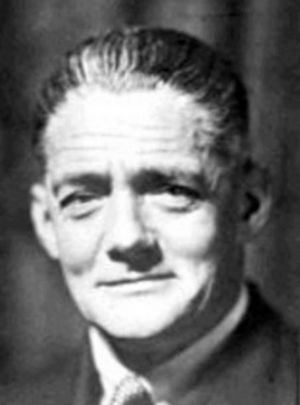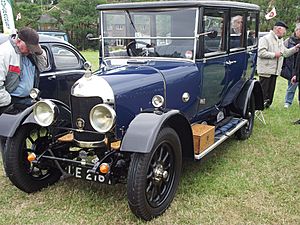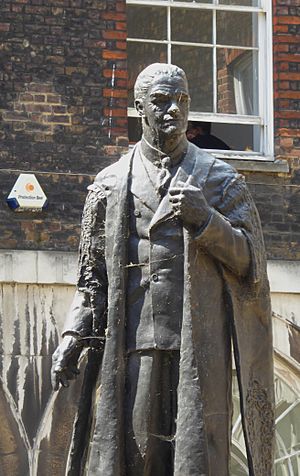William Morris, 1st Viscount Nuffield facts for kids
Quick facts for kids
The Viscount Nuffield
|
|
|---|---|

Morris c. 1920
|
|
| Born |
William Richard Morris
10 October 1877 Worcester, Worcestershire, England
|
| Died | 22 August 1963 (aged 85) Nuffield, Oxfordshire, England
|
| Occupation | Motor manufacturer and philanthropist |
| Known for |
|
| Spouse(s) |
Elizabeth Anstey
(m. 1903) |
William Richard Morris, 1st Viscount Nuffield (10 October 1877 – 22 August 1963), was an English car maker and a person who gave a lot of money to good causes. He started Morris Motors Limited, a famous car company. He is also known for creating the Nuffield Foundation, the Nuffield Trust, and Nuffield College, Oxford. He helped create what is now Nuffield Health through his role as President of BUPA. He chose his title, Viscount Nuffield, from the village of Nuffield where he lived.
Morris Motors was a big employer in Oxford, especially in the 1920s and 1930s. Many people moved to Oxford to find work in his factories. During this time, workers sometimes went on strike to ask for better pay and working conditions. The first successful strike happened in 1934.
William Morris had strong political views. He was against trade unions and held anti-Semitic beliefs. He also supported Oswald Mosley and British fascism by giving money to their causes. However, despite his personal views, the workers in his factories helped bring about more left-wing political action in Oxford during the 1930s.
Contents
Early Life and Career Beginnings
William Morris was born in 1877 in Worcester, England. When he was three years old, his family moved to Oxford.
Starting Out in Business
William Morris left school at 15. He first worked for a bicycle seller and repairer. Nine months later, he started his own bicycle repair business in a shed behind his parents' house. This business did well, so he opened a shop on High Street in Oxford. He began to build bicycles himself, calling them "The Morris."
Morris was a keen bicycle racer. He competed in races far from Oxford and was a champion in several areas for different distances.
Moving into Motorcycles and Cars
In 1901, he started working with motorcycles, designing the Morris Motor Cycle. By 1902, he had new buildings on Longwall Street. Here, he repaired bicycles, ran a taxi service, and sold, repaired, and rented out cars. He also sold cars from other brands.
In 1910, he built even bigger premises on Longwall Street. A local newspaper called it "The Oxford Motor Palace." He changed his business name to "The Morris Garage." This building is now student housing for New College, Oxford.
Building a Car Empire
Mass Production of Cars in the 1920s
In 1912, William Morris designed his own car, the "bullnose" Morris. He started building these cars in a former military college in Cowley, Oxford. He bought parts like engines and axles from the USA. When World War I began, his factory mostly made war supplies, including parts for naval mines.
After the war, car production grew quickly. From 400 cars in 1919, it jumped to 56,000 cars by 1925. Morris was a pioneer in bringing Henry Ford's mass production methods to the United Kingdom. He bought or built more factories in places like Abingdon, Birmingham, and Swindon.
In 1927, Morris bought Wolseley Motors Limited. This company was struggling, but Morris bought its assets for a large sum. Wolseley had been developing a small car, which Morris launched as the first Morris Minor in 1928. The first MG Midget car, launched in 1929, was based on the Minor.
Buying Component Suppliers
Morris often bought companies that supplied parts for his cars if they faced problems. For example, when his American engine supplier had trouble expanding, Morris bought their business in 1923. He called it Morris Engines Limited. He did the same with a company that made back-axles, renaming it Morris Commercial Cars Limited to make trucks and buses. In 1926, he also bought the company that made SU Carburettors.
Morris was impressed by American all-steel car bodies. He partnered with Edward G. Budd to create the Pressed Steel Company in 1926. This new factory was built across from Morris's own factory in Cowley. However, the partnership had problems, and Morris eventually lost his investment in this venture.
Car Manufacturing in the 1930s
Morris was a very famous industrialist of his time. In 1938, he was given the higher title of Viscount Nuffield. In September 1938, he bought the struggling Riley and Autovia car companies. He later sold them to Morris Motors Limited. He had also added Wolseley Motors Limited to Morris Motors in 1935. After he became Baron Nuffield, all his personal businesses were promoted as the Nuffield Organization.
Factory Strike of 1934
In July 1934, about 180 workers at a Morris factory went on strike. This was a "spontaneous walkout," meaning it happened without much planning. William Morris was against trade unions and had said he would not let them operate in his factories. The workers had various reasons for striking, including low wages and poor working conditions.
The Communist Party of Great Britain sent a strike leader, Abraham Lazarus, to help the workers. Before this strike, there was not much union activity in Morris's factories. On the 11th day of the strike, the managers gave in. Morris's factories agreed to raise wages and allow trade unions. This victory led to more support for the Labour Party, the Transport and General Workers' Union, and the Communist Party in Oxford.
World War II Contributions
The Supermarine Spitfire was a very advanced aircraft. In 1936, the Air Ministry ordered these planes, but by early 1938, none had been built. Lord Nuffield offered his help and the skills of his Morris Organization. He proposed building a huge new factory at Castle Bromwich to make Spitfires. He claimed it would produce four times as many planes as any other factory.
The government approved the "Nuffield Project" at a cost of £1.125 million, and Nuffield was put in charge. However, the factory was not built quickly, and costs rose. By May 1940, during the Battle of France, not one Spitfire had been built there. Lord Beaverbrook was then put in charge of aircraft production, and Nuffield was removed from the project. The plant was given to Vickers, the company that owned Supermarine.
Later Years and Legacy
After the War

In 1952, Morris Motors Limited joined with the Austin Motor Company to form a new company called British Motor Corporation (BMC). Nuffield was the chairman for the first year.
Morris retired as a director of BMC in December 1952, at age 75. He became honorary president and continued to visit his office and advise his colleagues.
Honours and Awards
William Morris received many honours for his work and generosity:
- He was made an Officer of the Order of the British Empire (OBE) in 1918.
- He became a baronet in 1929.
- He was made Baron Nuffield in 1934.
- In 1938, he was further honoured as Viscount Nuffield.
- He became a Fellow of the Royal Society in 1939.
- He was made a Knight Grand Cross of the Order of the British Empire in 1941.
- He became a Companion of Honour (CH) in 1958.
Personal Life and Giving Back
William Morris married Elizabeth Anstey in 1903. They did not have any children. He gave away a large part of his wealth to help others.
In 1937, he founded Nuffield College, Oxford. This was a new college for students studying for advanced degrees, and it was the first college at Oxford University to admit both men and women.
He also gave £50,000 to help the Sea Cadet Corps expand. He donated £60,000 to the University of Birmingham for a building to house a cyclotron, a type of particle accelerator. In 1938, he offered to give an iron lung (a breathing machine) made in his factory to any hospital in Britain or the Empire that asked for one. Over 1,700 were given out.
In 1943, he started the Nuffield Foundation with £10 million. This foundation aims to improve education and social welfare.
After his death, his home, Nuffield Place, was given to Nuffield College. It is now looked after by the National Trust and is open to the public.
Morris is also remembered at the Morris Motors Museum in the Oxford Bus Museum. Buildings are named after him at Coventry University, Guy's Hospital in London, and the University of Southampton. The Lady Nuffield Care Home is named after his wife.
His childhood home in James Street has a special blue plaque to mark its historical importance. William Morris died in August 1963, at 85 years old. Since he had no children, his titles ended with him. He was cremated, and his ashes are buried next to his wife's in Nuffield churchyard.
Views and Support for Political Groups
Historians have noted that William Morris was against trade unions. He also held anti-Semitic views, meaning he had prejudices against Jewish people. He was a major financial supporter of Oswald Mosley and his British fascist movement. Between 1931 and 1932, Morris gave Mosley £35,000 to fund the anti-Semitic newspaper Action. In 1930, he gave £50,000 to Mosley's fascist New Party, which later joined the British Union of Fascists.
Mosley spoke highly of Morris, calling him his "chief backer" and a "good and honest man." After 1932, as the reputation of the British Union of Fascists worsened, Morris stopped publicly supporting them. However, he continued to subscribe to anti-Semitic newspapers for many years.
Historian Dave Renton describes Morris as a very important wealthy supporter of Mosley's fascist movement. Renton also says Morris was "fiercely anti-Semitic" in his private life. His personal papers show comments like: "it is a well-known fact that every government in my England is Jew controlled regardless of the Party in power."
Despite Morris's personal political beliefs, the workers in his factories organized to improve their low pay and harsh conditions. Their actions helped start a wave of left-wing political activity across Oxford in the 1930s.
Kidnap Attempt
In May 1938, a man named Patrick Tuellman tried to kidnap Morris. He wanted a large sum of money, £100,000, as a ransom. However, Tuellman's plan was revealed by an accomplice to the Oxford City Police. The police told Morris about the plan and set up a trap to catch Tuellman. Morris was very interested in the preparations and attended all the meetings.
On May 28, police caught Tuellman in his car in Cowley. He had two automatic pistols, ammunition, and items for disguise. Tuellman was found guilty in court and was sentenced to seven years of hard labour.
Images for kids











